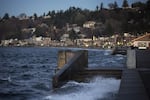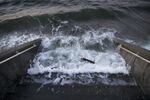Tom and Marie Cawrse live on the far east side of Port Townsend, on the northeast point of Washington's Olympic Peninsula, right on the beach.
Since their house was built three decades ago, ice caps have been melting and the ocean’s been expanding as it warms up.
The Cawrses got a taste of just how close the sea might come to their home in March 2016, when a massive storm blew into Port Townsend at the same time as an extra high high tide known as a king tide.

Tom and Marie Cawrse live right next on the beach in Port Townsend.
Eilis O'Neill, KUOW / EarthFix
“We probably had 4- to 6-foot waves coming ashore here,” Tom Cawrse remembers. It was just before dawn, and 60 mile-per-hour winds were pushing the high water towards the Cawrses’ house. “There was a lot of spray hitting the east side of our house, and you could feel vibrations coming through the house. I got out of bed and came out and looked, and I thought, ‘Oh my goodness, if this goes on a lot we're going to have to move the house.’”
Across the Pacific Northwest, the sea's already at the doorstep of homes, businesses, infrastructure, and habitat--and the problem's only going to get worse as the sea continues to rise. In the winter, king tides give us a glimpse of what might be at risk. In Washington and Oregon, nearly 40,000 people live in homes that are likely to get flooded during the next few decades.
And it’s not just houses that are at risk; it’s billions of dollars of infrastructure. Sewage treatment plants in Olympia and other cities could be destroyed by salt water unless they are modified or moved. The Port of Tacoma and other highly contaminated SuperFund sites could soon be underwater. And hundreds of miles of roads might get regularly flooded.

Water spills over a set of stairs that typically lead to the beach during a King Tide at Alki Beach Park on Tuesday, December 5, 2017, in West Seattle.
Megan Farmer / KUOW
"The implications of sea level rise are more expensive than we could ever imagine having budget to cover," says Guillaume Mauger, an expert on flooding and climate change adaptation at the University of Washington's Climate Impacts Group.
Even if we stop emitting carbon tomorrow, he says, “We're virtually guaranteed to get six inches of sea level rise in the next 50 years.”
Sea Level Rise On The North Olympic Peninsula
Three communities on the peninsula offer a glimpse of how rising seas will threaten homes, businesses and infrastructure in the Northwest. Within the next 12 years, annual flooding during coastal storms is expected to reach areas it hasn't before. By 2100, the potential damage grows significantly.
Tony Schick, OPB/EarthFix. Sources: North Olympic Peninsula Development Council; Ian Miller, Washington Sea Grant.
That’s more than a foot above where the sea was in 1900, which is when a lot of our infrastructure was built.
One way to get a glimpse of the future is to look at a king tide today. That’s why I headed to Olympia during one of January’s king tides. I met Eric Christensen, who does sea level rise planning with Olympia’s Public Works Department, at the Budd Inlet, the very southern end of Puget Sound.
“We’ve got a tide coming in that should hit about 17 feet, which happens a few times a year here,” Christensen says. “With a foot of sea level rise, we could see this happening maybe 30 times a year. A few times a year, we’d see water creep over the shoreline and flood up to 20, 25 square blocks of downtown.”

Eric Shalit watches the sunset during a bike ride on Tuesday, December 5, 2017, in West Seattle.
Megan Farmer / KUOW
Christensen says a tide like today’s, plus that six inches of sea level rise scientists say we’re guaranteed to get, could mean “you’ll begin to see water in the streets. This corner here will flood. Columbia Street, the next block over, will flood. The parking lot that you parked in you wouldn’t want to walk to your car.”
Christensen estimates it will cost $60 to 65 million to protect downtown Olympia from a rising sea, but, if the city did nothing to prepare, the damage would cost billions.
Olympia is ahead of most other cities in terms of sea level planning and preparedness; many communities that could face grave threats have yet to get started.
“Sea level rise is inevitable, and sea level rise is going to change the landscape,” Christensen says. “This is my community, and I feel very strongly that I’d like to protect it.”
Back in Port Townsend, the Cawrses’ short-term plan is to keep building the berm between the beach and their house higher and higher.
But, long-term, Tom Cawrse says, “These houses will probably have to be moved. That's probably the final outcome but it won't affect Marie and myself because we'll be gone.”
This story was produced for KUOW's Burning Question project and its latest series, which explores the question: What would a climate-friendly Seattle actually look like?







